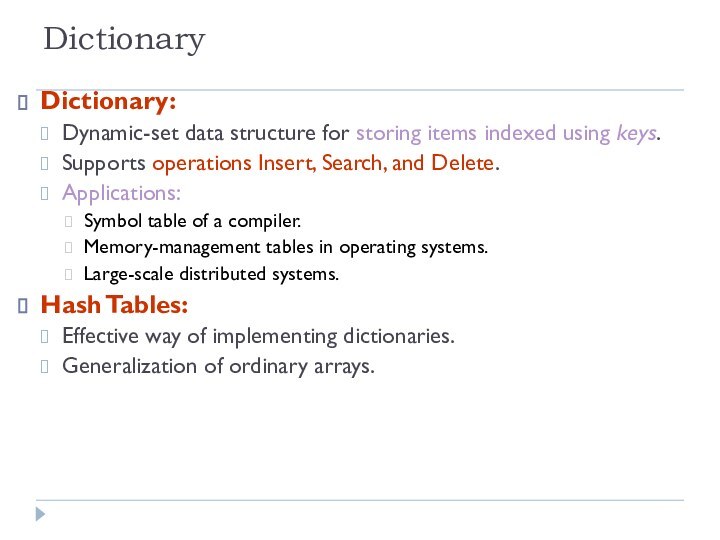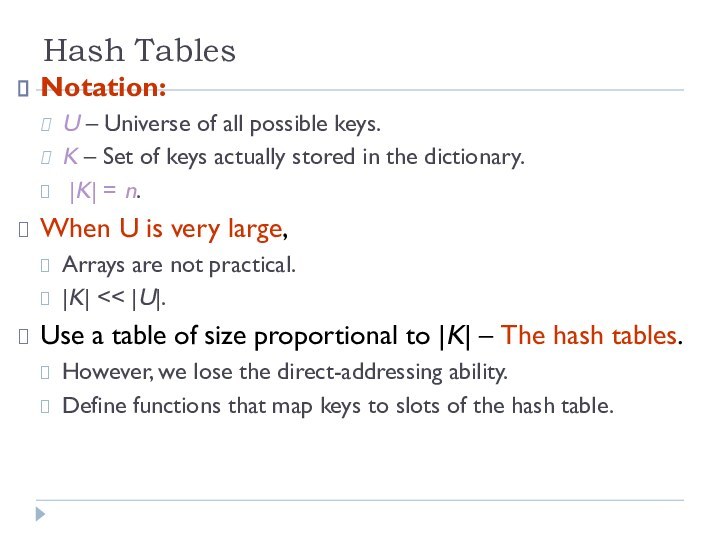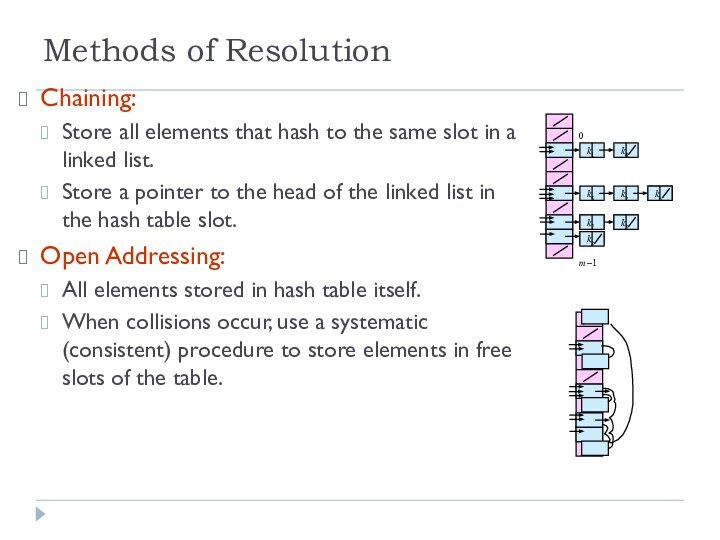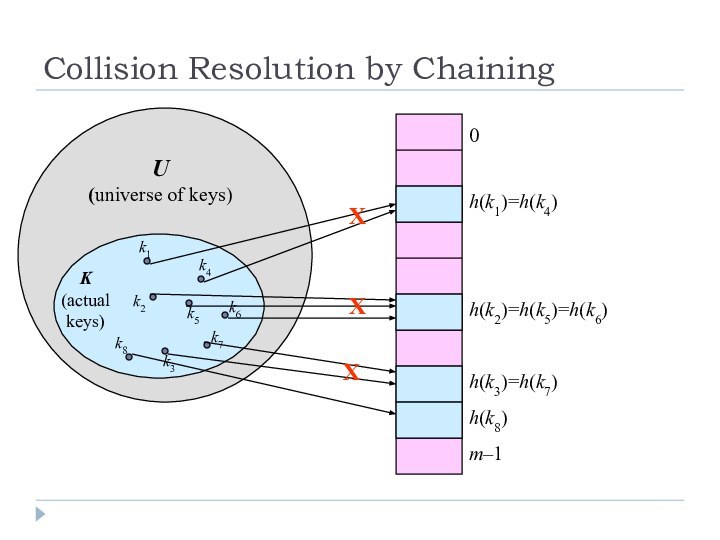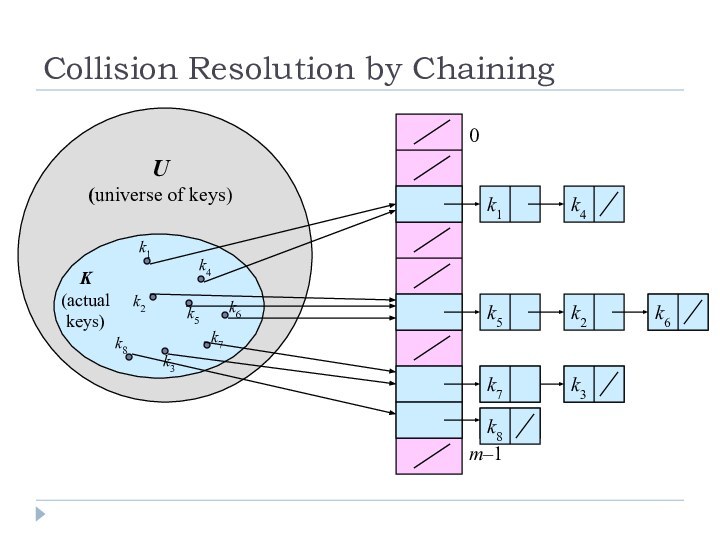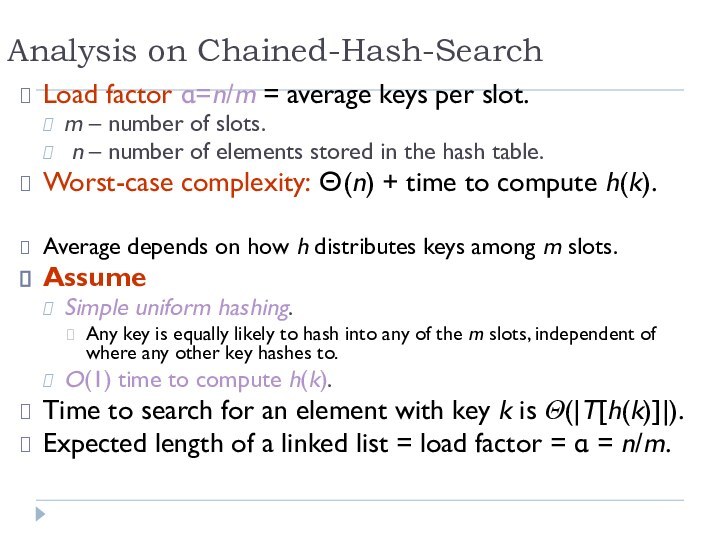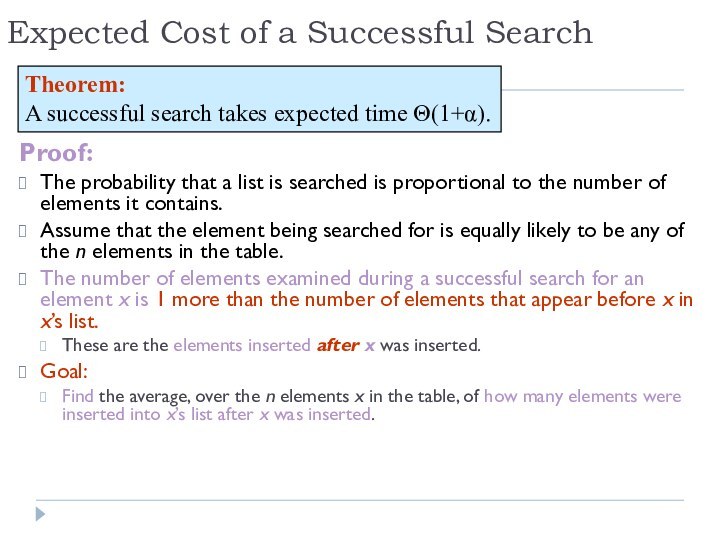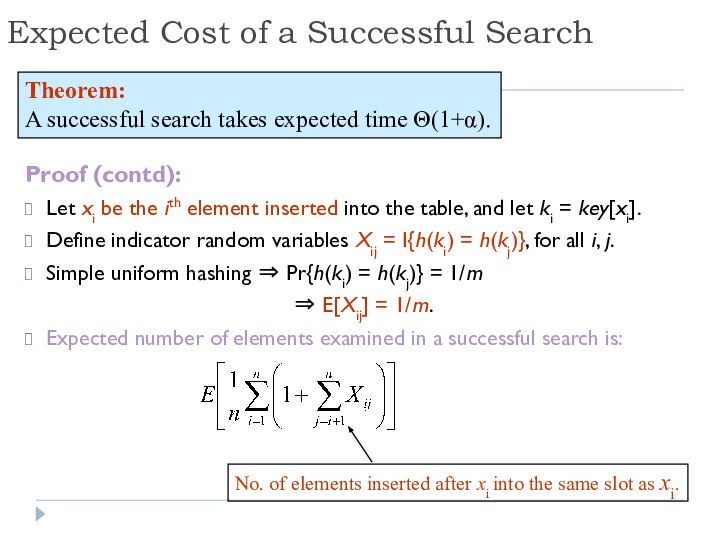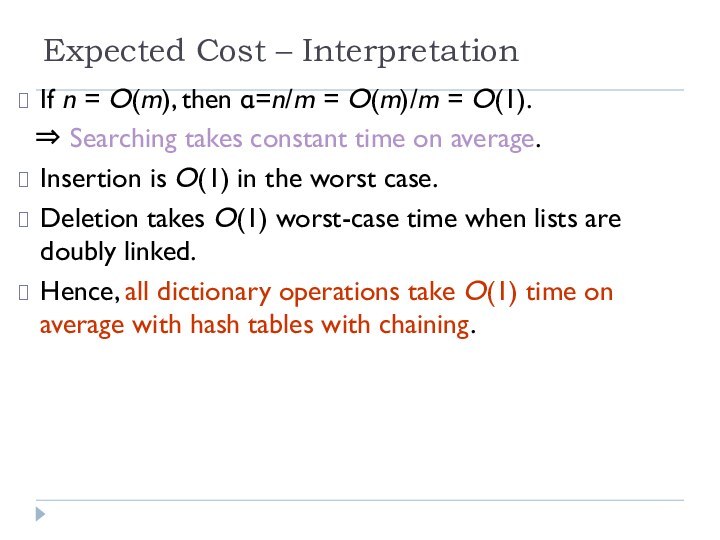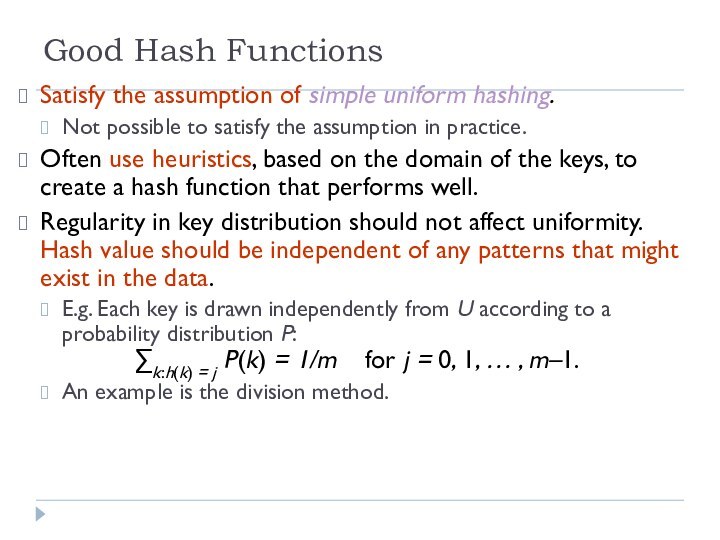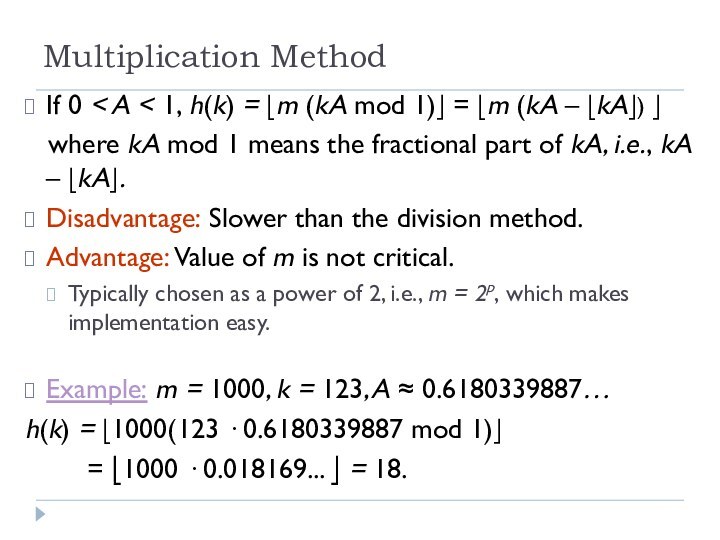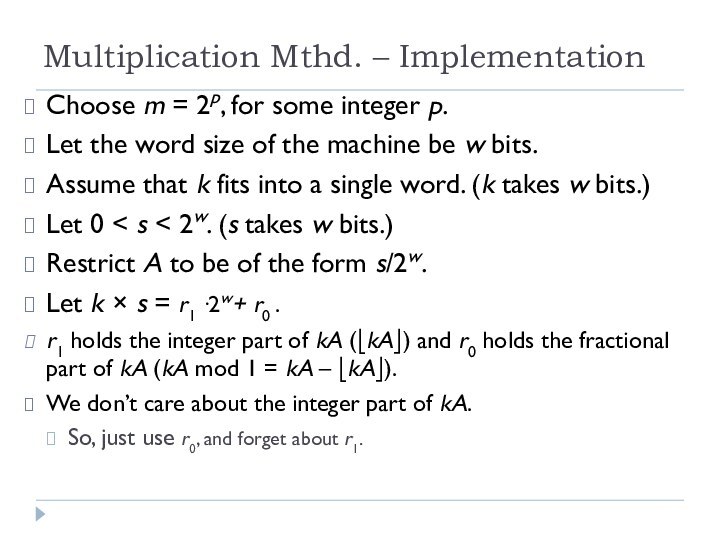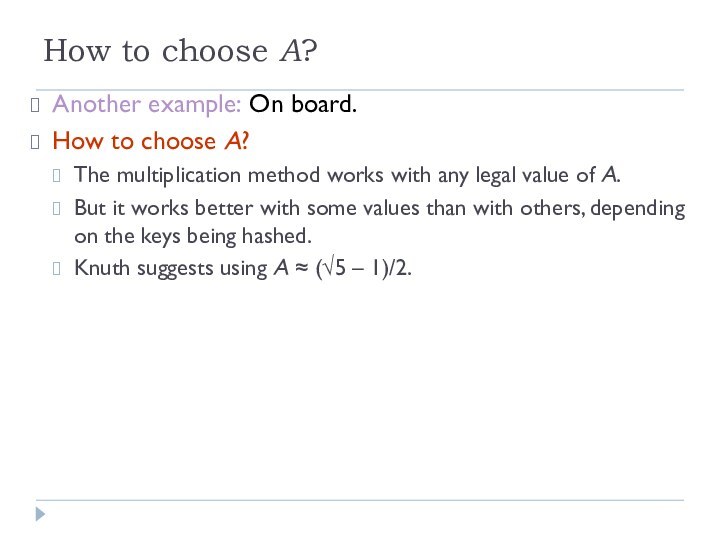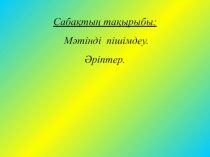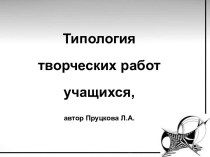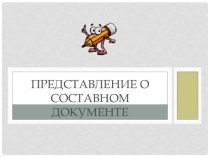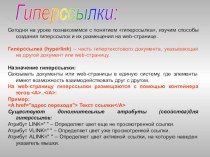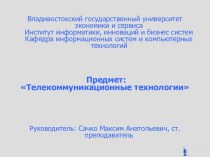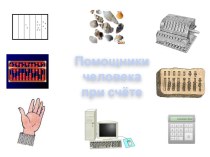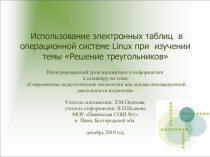Слайд 2
Dictionary
Dictionary:
Dynamic-set data structure for storing items indexed
using keys.
Supports operations Insert, Search, and Delete.
Applications:
Symbol table of
a compiler.
Memory-management tables in operating systems.
Large-scale distributed systems.
Hash Tables:
Effective way of implementing dictionaries.
Generalization of ordinary arrays.
Слайд 3
Direct-address Tables
Direct-address Tables are ordinary arrays.
Facilitate direct
addressing.
Element whose key is k is obtained by indexing
into the kth position of the array.
Applicable when we can afford to allocate an array with one position for every possible key.
i.e. when the universe of keys U is small.
Dictionary operations can be implemented to take O(1) time.
Details in Sec. 11.1.
Слайд 4
Hash Tables
Notation:
U – Universe of all possible keys.
K
– Set of keys actually stored in the dictionary.
|K| = n.
When U is very large,
Arrays are not practical.
|K| << |U|.
Use a table of size proportional to |K| – The hash tables.
However, we lose the direct-addressing ability.
Define functions that map keys to slots of the hash table.
Слайд 5
Hashing
Hash function h: Mapping from U to the
slots of a hash table T[0..m–1].
h : U → {0,1,…, m–1}
With arrays, key k maps to slot A[k].
With hash tables, key k maps or “hashes” to slot T[h[k]].
h[k] is the hash value of key k.
Слайд 6
Hashing
0
m–1
h(k1)
h(k4)
h(k2)=h(k5)
h(k3)
U
(universe of keys)
K
(actual
keys)
k1
k2
k3
k5
k4
collision
Слайд 7
Issues with Hashing
Multiple keys can hash to the
same slot – collisions are possible.
Design hash functions such
that collisions are minimized.
But avoiding collisions is impossible.
Design collision-resolution techniques.
Search will cost Ө(n) time in the worst case.
However, all operations can be made to have an expected complexity of Ө(1).
Слайд 8
Methods of Resolution
Chaining:
Store all elements that hash
to the same slot in a linked list.
Store a
pointer to the head of the linked list in the hash table slot.
Open Addressing:
All elements stored in hash table itself.
When collisions occur, use a systematic (consistent) procedure to store elements in free slots of the table.
k2
0
m–1
k1
k4
k5
k6
k7
k3
k8
Слайд 9
Collision Resolution by Chaining
0
m–1
h(k1)=h(k4)
h(k2)=h(k5)=h(k6)
h(k3)=h(k7)
U
(universe of keys)
K
(actual
keys)
k1
k2
k3
k5
k4
k6
k7
k8
h(k8)
X
X
X
Слайд 10
Collision Resolution by Chaining
k2
0
m–1
U
(universe of keys)
K
(actual
keys)
k1
k2
k3
k5
k4
k6
k7
k8
k1
k4
k5
k6
k7
k3
k8
Слайд 11
Hashing with Chaining
Dictionary Operations:
Chained-Hash-Insert (T, x)
Insert x at
the head of list T[h(key[x])].
Worst-case complexity – O(1).
Chained-Hash-Delete (T,
x)
Delete x from the list T[h(key[x])].
Worst-case complexity – proportional to length of list with singly-linked lists. O(1) with doubly-linked lists.
Chained-Hash-Search (T, k)
Search an element with key k in list T[h(k)].
Worst-case complexity – proportional to length of list.
Слайд 12
Analysis on Chained-Hash-Search
Load factor α=n/m = average keys
per slot.
m – number of slots.
n – number
of elements stored in the hash table.
Worst-case complexity: Θ(n) + time to compute h(k).
Average depends on how h distributes keys among m slots.
Assume
Simple uniform hashing.
Any key is equally likely to hash into any of the m slots, independent of where any other key hashes to.
O(1) time to compute h(k).
Time to search for an element with key k is Θ(|T[h(k)]|).
Expected length of a linked list = load factor = α = n/m.
Слайд 13
Expected Cost of an Unsuccessful Search
Proof:
Any key not
already in the table is equally likely to hash
to any of the m slots.
To search unsuccessfully for any key k, need to search to the end of the list T[h(k)], whose expected length is α.
Adding the time to compute the hash function, the total time required is Θ(1+α).
Theorem:
An unsuccessful search takes expected time Θ(1+α).
Слайд 14
Expected Cost of a Successful Search
Proof:
The probability that
a list is searched is proportional to the number
of elements it contains.
Assume that the element being searched for is equally likely to be any of the n elements in the table.
The number of elements examined during a successful search for an element x is 1 more than the number of elements that appear before x in x’s list.
These are the elements inserted after x was inserted.
Goal:
Find the average, over the n elements x in the table, of how many elements were inserted into x’s list after x was inserted.
Theorem:
A successful search takes expected time Θ(1+α).
Слайд 15
Expected Cost of a Successful Search
Proof (contd):
Let xi
be the ith element inserted into the table, and
let ki = key[xi].
Define indicator random variables Xij = I{h(ki) = h(kj)}, for all i, j.
Simple uniform hashing ⇒ Pr{h(ki) = h(kj)} = 1/m
⇒ E[Xij] = 1/m.
Expected number of elements examined in a successful search is:
Theorem:
A successful search takes expected time Θ(1+α).
No. of elements inserted after xi into the same slot as xi.
Слайд 16
Proof – Contd.
(linearity of expectation)
Expected total time for
a successful search = Time to compute hash function
+ Time to search
= O(2+α/2 – α/2n) = O(1+ α).
Слайд 17
Expected Cost – Interpretation
If n = O(m), then
α=n/m = O(m)/m = O(1).
⇒ Searching takes constant
time on average.
Insertion is O(1) in the worst case.
Deletion takes O(1) worst-case time when lists are doubly linked.
Hence, all dictionary operations take O(1) time on average with hash tables with chaining.
Слайд 18
Good Hash Functions
Satisfy the assumption of simple uniform
hashing.
Not possible to satisfy the assumption in practice.
Often use
heuristics, based on the domain of the keys, to create a hash function that performs well.
Regularity in key distribution should not affect uniformity. Hash value should be independent of any patterns that might exist in the data.
E.g. Each key is drawn independently from U according to a probability distribution P:
∑k:h(k) = j P(k) = 1/m for j = 0, 1, … , m–1.
An example is the division method.
Слайд 19
Keys as Natural Numbers
Hash functions assume that the
keys are natural numbers.
When they are not, have to
interpret them as natural numbers.
Example: Interpret a character string as an integer expressed in some radix notation. Suppose the string is CLRS:
ASCII values: C=67, L=76, R=82, S=83.
There are 128 basic ASCII values.
So, CLRS = 67·1283+76 ·1282+ 82·1281+ 83·1280 = 141,764,947.
Слайд 20
Division Method
Map a key k into one of
the m slots by taking the remainder of k
divided by m. That is,
h(k) = k mod m
Example: m = 31 and k = 78 ⇒ h(k) = 16.
Advantage: Fast, since requires just one division operation.
Disadvantage: Have to avoid certain values of m.
Don’t pick certain values, such as m=2p
Or hash won’t depend on all bits of k.
Good choice for m:
Primes, not too close to power of 2 (or 10) are good.
Слайд 21
Multiplication Method
If 0 < A < 1, h(k)
= ⎣m (kA mod 1)⎦ = ⎣m (kA –
⎣kA⎦) ⎦
where kA mod 1 means the fractional part of kA, i.e., kA – ⎣kA⎦.
Disadvantage: Slower than the division method.
Advantage: Value of m is not critical.
Typically chosen as a power of 2, i.e., m = 2p, which makes implementation easy.
Example: m = 1000, k = 123, A ≈ 0.6180339887…
h(k) = ⎣1000(123 · 0.6180339887 mod 1)⎦
= ⎣1000 · 0.018169... ⎦ = 18.
Слайд 22
Multiplication Mthd. – Implementation
Choose m = 2p, for
some integer p.
Let the word size of the machine
be w bits.
Assume that k fits into a single word. (k takes w bits.)
Let 0 < s < 2w. (s takes w bits.)
Restrict A to be of the form s/2w.
Let k × s = r1 ·2w+ r0 .
r1 holds the integer part of kA (⎣kA⎦) and r0 holds the fractional part of kA (kA mod 1 = kA – ⎣kA⎦).
We don’t care about the integer part of kA.
So, just use r0, and forget about r1.
Слайд 23
Multiplication Mthd – Implementation
We want ⎣m (kA mod
1)⎦. We could get that by shifting r0 to
the left by p = lg m bits and then taking the p bits that were shifted to the left of the binary point.
But, we don’t need to shift. Just take the p most significant bits of r0.
k
s = A·2w
r0
r1
w bits
×
h(k)
extract p bits
·
binary point

